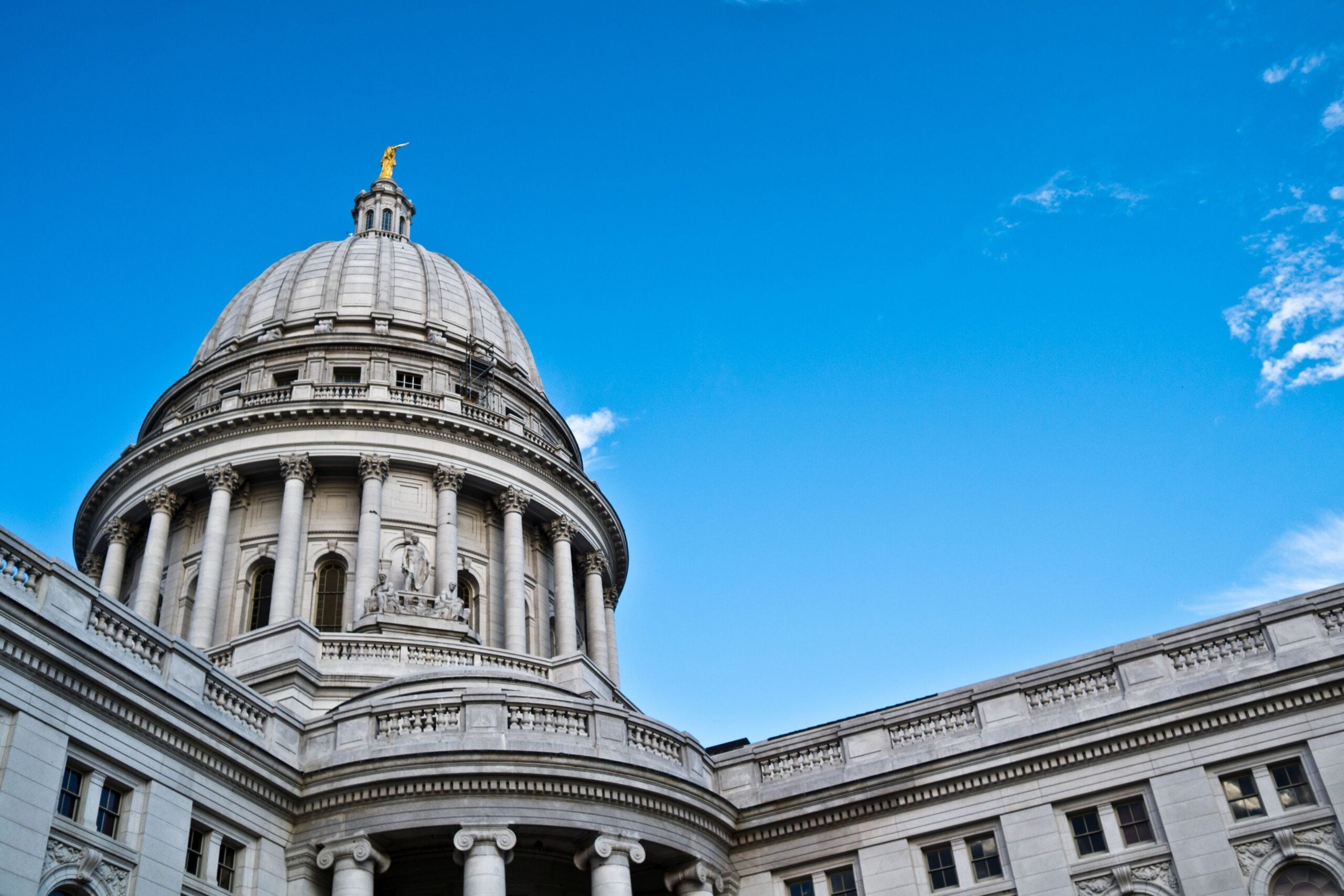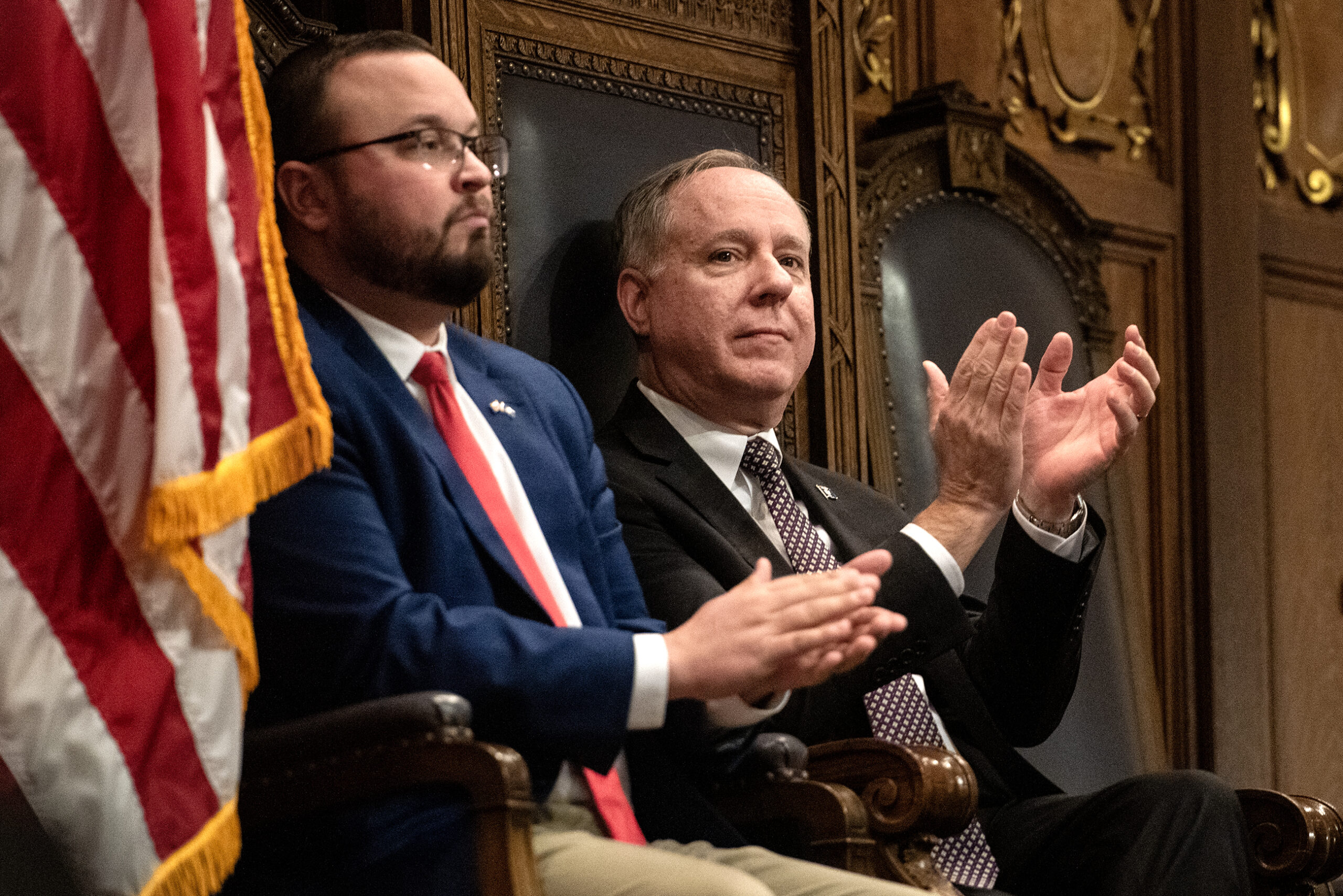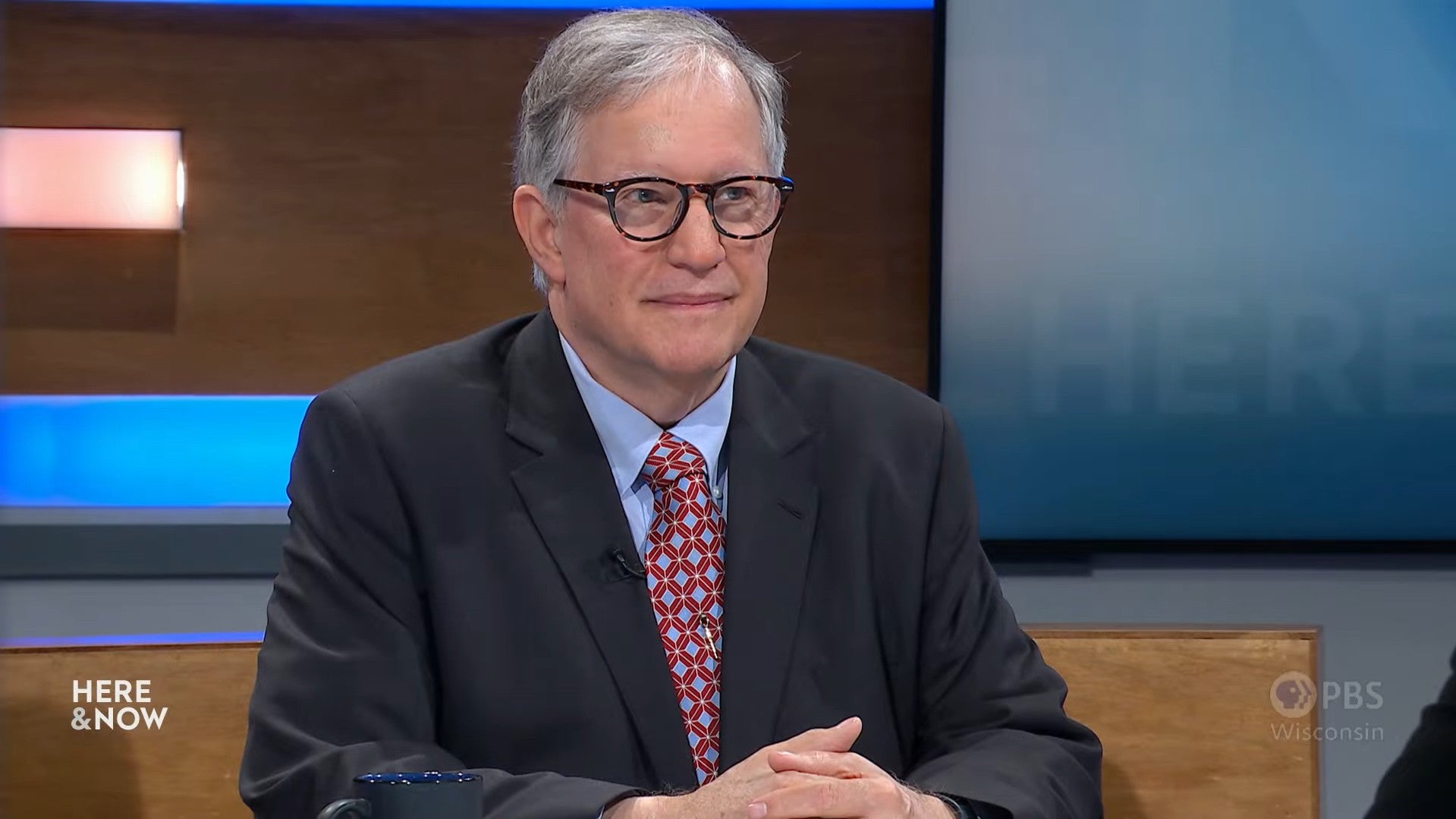Wisconsin Republicans have a strong chance to expand their majorities in the state Assembly and Senate Tuesday, and with the help of the new Republican-drawn legislative map, they could be on the verge of veto-proof supermajorities.
It’s especially significant in a state where Democratic Gov. Tony Evers vetoed a record number of Republican bills in the last legislative session. Republicans could pass most of the bills again next session.
Republicans would need to win two-thirds majorities in each chamber of the Legislature to gain the power to override vetoes. In the state Senate, that would mean flipping just one Democratic district to win 22 out of 33 seats, a feat eminently possible under the makeup of the new map.
News with a little more humanity
WPR’s “Wisconsin Today” newsletter keeps you connected to the state you love without feeling overwhelmed. No paywall. No agenda. No corporate filter.
In the state Assembly, Republicans would need to flip five districts to win 66 seats out of 99 districts to hit the two-thirds veto-proof threshold that would let them set the agenda in state government no matter who is in the governor’s office.
“Winning 66 seats would require a Republican victory of a size that we haven’t seen for a decade,” said John Johnson, a research fellow at Marquette University’s Lubar Center for Public Policy Research.
“That’s possible,” Johnson said. “It would be remarkable.”
Johnson, who analyzed the partisan lean of each district based on the way it performed in the last two presidential elections and the 2018 governor’s race, said it’s easy to imagine Republicans flipping four of those Assembly districts based on their performance there in recent elections. But they’d also have to flip a fifth Assembly seat where — strictly by the numbers — a Democratic candidate would typically be favored to win.
Democrats could also make that task harder by flipping one of a few competitive Republican districts.
Democratic Assembly districts Republicans could flip
13th Assembly District
One of the seats currently held by Democrats that’s highly likely to flip is the 13th Assembly District west of Milwaukee. Democrat Sarah Harrison of Brookfield faces Republican Tom Michalski of Elm Grove. The current officeholder, state Rep. Sarah Rodriguez, D-Brookfield, is not seeking reelection as she runs for lieutenant governor.
Under the old Republican-drawn map, the 13th started out the decade in GOP hands, but the suburban seat shifted to the left, and Rodriguez narrowly won it in 2020.
The old 13th was a 50-50 district under the old map. Under the new map, it gives Republicans a built-in 16 point advantage.
74th Assembly District
The 74th Assembly District is one of two competitive Northern Wisconsin Assembly districts along the Lake Superior shoreline where retiring incumbents have presented openings for Republicans.
Washburn Democrat John Adams faces Republican Chanz Green, who lives near Mason.
Outgoing state Rep. Beth Meyers, D-Bayfield, was first elected in 2014 and was able to win the district despite its slight GOP lean. Under the old map, the district favored Republicans by 2 percentage points. The new map favors the GOP by roughly one point.
73rd Assembly District
The other open northern Wisconsin seat, the 73rd Assembly District, includes parts of Douglas, Washburn and Burnett Counties along the Wisconsin-Minnesota border. Democrat Laura Gapske of Superior faces Republican Angie Sapik of Lake Nebagamon.
Democratic incumbent Nick Milroy of South Range was first elected to the district in 2008, but his last election was about as close as they come. In 2020, Milroy won the seat by just 139 votes out of more than 33,000 cast.
The district under the new political map shifted slightly to the right. Marquette’s analysis shows that it went from a four-point Democratic lean under the old map to just a one-point Democratic edge under the new map.
94th Assembly District
One of the other districts targeted by Republicans features a Democratic incumbent who is no stranger to highly competitive elections.
Rep. Steve Doyle, D-Onalaska, first won election to the Assembly in 2011. That race was a special election to fill a vacancy left when former Assembly Speaker Mike Huebsch left the Legislature for a cabinet position in former Republican Gov. Scott Walker’s administration.
This year, Doyle faces Republican challenger Ryan Huebsch, who is Mike Huebsch’s son.
Doyle repeatedly won the old district despite a two-point GOP lean. The new district still leans Republican by one point.
Democratic Assembly districts where Republicans are competing
71st Assembly District
It would likely take a Republican wave year for the GOP to flip other Democratic districts, such as the 71th Assembly District, currently held by Katrina Shankland, D-Stevens Point.
Shankland first won election to the Assembly in 2012 and won her last election in 2020 by 11 percentage points. This year, Shankland faces Republican Scott Soik of Stevens Point.
The 71st went from an eight-point Democratic edge under the old map to a seven-point edge under the new map.
54th Assembly District
In the 54th Assembly District, state Rep. Gordon Hintz, D-Oshkosh is not seeking reelection to a seat he first won in 2006.
Running to replace him are Democrat Lori Palmeri and Republican Donnie Herman, both of Oshkosh.
Hintz won the seat by about 8 percentage points two years ago. The district favored Democrats by 9 percentage points under the old map and maintains a nine-point Democratic edge under the new map.
64th Assembly District
The 64th Assembly District in Kenosha is another seat where it would likely take a big GOP year for Republicans to flip the seat, but both parties are focused on the race.
The incumbent, state Rep. Tip McGuire, D-Kenosha, won his last election in 2020 by about 12 percentage points. He faces Republican challenger Ed Hibsch of Kenosha this year.
The district had an 11-point Democratic edge under the old map, and under the new map, it has a built-in 12-point Democratic lean.
What remains unclear is whether local politics will shake up long term political trends in Kenosha, where residents experienced an especially tumultuous two years that saw the city’s downtown burned.
Money is flowing here in the late stages of the race. The Democratic Party of Wisconsin has transferred $220,000 to McGuire’s campaign since Oct. 28. The Republican Assembly Campaign Committee and the Republican Party of Wisconsin also reported $224,000 in in-kind contributions to Hibsch since Oct. 25.
57th Assembly District
Marquette University’s Johnson said the 57th Assembly District in Appleton is another where Republicans could potentially make gains, though the numbers there favor Democrats.
Incumbent state Rep. Lee Snodgrass, D-Appleton, faces a challenge from Republican Andrew Fox of Menasha.
Snodgrass won her last race two years ago by about 13 percentage points. The district had a built-in 12 point advantage under the old map and maintains that edge under the new map.
45th Assembly District
The 45th Assembly District would be among the biggest long shots for Republicans by the numbers, although it’s another race where both parties have spent money in the late stages of the race. Democrat Clinton Anderson faces Republican Jeff Klett, both of Beloit.
The incumbent, Rep. Mark Spreitzer, D-Beloit, is not seeking reelection to the district, opting to run for an open state Senate seat instead.
Spreitzer won the district by about 10 percentage points in 2020. The district had a 13-point Democratic edge under the old map, a margin that grew to 15 points under the new map.
Republican Assembly districts where Democrats are competing
51st Assembly District
State Rep. Todd Novak, R-Dodgeville, who is no stranger to competitive races, is on a short list of districts Democrats are hoping to flip in 2022. Novak won his 2020 election by about a 4-point margin.
Novak, who was first elected in 2014, faces Democratic challenger Leah Spicer of Avoca.
The 51st Assembly district west of Madison stretches from Reedsburg in the north to the Illinois border in the south. It leaned Democratic by about 4 percentage points under the old map. The new map made it slightly more Republican, but it still leans Democratic by about two points.
84th Assembly District
In the 84th Assembly District, state Rep. Mike Kuglitsch retired from the Legislature. Hales Corners Democrat Lu Ann Bird is running against Greenfield Republican Bob Donovan to replace him.
Kuglitsch ran unopposed two years ago in a district that had an 11-point Republican lean under the old map. The district got considerably more Democratic in the new map and now leans Republican by just 2 percentage points.
The district is in the suburbs of Milwaukee, where Democrats have made gains in recent years.
33rd Assembly District
Democrats could also plausibly flip the 33rd Assembly District, a seat where incumbent Rep. Cody Horlacher, R-Mukwonago, was drawn out of the new district.
The seat presents a unique opportunity for Democrats for a couple of reasons. For one, it got considerably more Democratic under the new map, shifting from a 23-point Republican advantage to just a four-point GOP edge.
The Democratic candidate is also a sitting lawmaker, although he was also moved out of his old district under the new map. State Rep. Don Vruwink, D-Milton, had been elected since 2016 to the old 43rd Assembly District. He faces Jefferson Republican Scott Johnson this year.
Competitive State Senate Districts
25th State Senate District
In the state Senate, where Republicans need to flip one district to win a supermajority, they’re targeting the 25th State Senate District, where incumbent state Sen. Janet Bewley, D-Mason, is stepping down. Bewley, the Senate’s minority leader, was first elected to the district in 2014 after serving two terms in the Assembly.
She was able to win the district even as it was trending Republican. According to Marquette’s analysis, the 25th Senate District had a six-point Republican advantage under the old map. Under the new map, that grew to seven points.
Democrat Kelly Westlund of Ashland faces Republican Romaine Quinn of Cameron in this year’s election. Westlund is a former candidate for Congress. Quinn previously served in the state Assembly.
The Senate district includes two of the Assembly districts Republicans are hoping to flip, underscoring Northern Wisconsin’s importance in this year’s midterms.
31st State Senate District
Eau Claire’s 31st State Senate District was a competitive seat under the old map, and it’s competitive under the new map, too. But under both maps, the district has a two percent Republican lean.
That presents a challenge for incumbent Sen. Jeff Smith, D-Eau Claire in his race against Whitehall Republican David Estenson this year.
Smith won the race four years ago by a margin of almost 6 percentage points.
5th State Senate District
The 5th State Senate District had been trending Democratic over the past decade until Republicans redrew the district this year. Now, what had been a district that favored Democrats by one percentage point favors Republicans by seven.
West Allis Democrat Jessica Katzenmeyer faces Brookfield Republican Rob Hutton, a former state representative who lost his race for the 13th Assembly District two years ago.
Incumbent state Sen. Dale Kooyenga, R-Brookfield, is not seeking reelection.
A two-thirds majority in either chamber would be rare
The last time either party had a two-thirds supermajority in the Legislature was 1977, when Democrats held a 23-10 seat advantage in the Senate and a 66-33 seat advantage in the Assembly.
Neither party has hit a two-thirds majority in either chamber since, according to an historical record maintained in the Wisconsin Blue Book. The closest Republicans got was in the 2017 session when they held 64 seats in the Assembly.
But Johnson, with Marquette University, expects that to change in the Wisconsin Senate this year.
“In the State Senate, it will probably be a Republican supermajority,” Johnson said. “Even if Gov. Evers wins reelection narrowly, I think the most likely outcome is still a Republican supermajority there.”
Johnson is less sure about the state Assembly, but he said that if it’s the kind of GOP wave year that propels Republicans to a supermajority in both chambers, they probably wouldn’t need to override any vetoes.
“If they win a supermajority, I think (Republicans) will almost certainly have also won the governor’s mansion,” Johnson said.
Johnson said that for Republicans to win a supermajority, they’d likely need 2022 to be a GOP wave election along the lines of 2010. That was the year Republicans flipped control of the Legislature and recaptured the governor’s office, letting them draw a political map that helped cement lopsided majorities in the Legislature for the past decade, and possibly more to come.
Wisconsin Public Radio, © Copyright 2026, Board of Regents of the University of Wisconsin System and Wisconsin Educational Communications Board.





